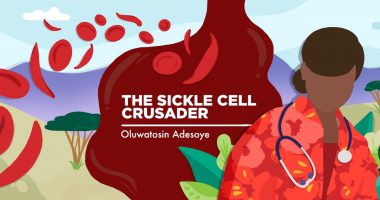What I’ve Learned About Protein and Sickle Cell Disease

Sickle Cell Awareness Month is here again! I’m very excited about this one because it’s the first year I can wholeheartedly participate. Last year, I was still struggling to accept my son’s diagnosis, and even though I had announced I would stay strong and do my utmost to keep him well, I was terrified about the future.
These days, I’m more excited about what’s possible, less fearful about things that could go wrong, and therefore, more enthused about sharing what’s within my control that may keep him well, such as healthy nutrition.
Nutrition is the least explored area of sickle cell management, but many interesting research studies provide insight into its benefits in reducing sickle cell severity. So far, I’ve learned that people with sickle cell disease are prone to nutrient deficiencies and need more energy (calories) than a person without the disease.
During this month and beyond, I’d like to share what I’ve learned in the hopes that it will benefit someone else.
Protein is the first nutrient I’d like to introduce.
Beyond strong muscles, we all need protein to make hormones, immune cells, antibodies, and enzymes. We also need it to maintain bone health, and in some cases, provide energy. It turns out that people with sickle cell have a higher metabolic rate and therefore need more protein than those without the disease.
In people who don’t have sickle cell disease, red blood cells have a lifespan of 100-120 days. This is shortened to 8-25 days for those with sickle cell disease. This means that the bone marrow is constantly under pressure to churn out new red blood cells. This process needs plenty of energy, and since blood cells are made of protein, a person with sickle cell needs more protein.
Protein is made up of building blocks called amino acids. Humans need 20 amino acids to stay healthy. Our bodies can make 11 of them — the nonessential amino acids — as long as we eat enough food. But we can only get the other nine from our diet. Those nine amino acids are called essential amino acids.
Protein is rich in animal foods, including chicken, beef, eggs, and fish, but also in plant foods such as beans, lentils, nuts, and seeds. The proteins in animal foods are of a higher quality than those in plant foods because our bodies can absorb them more easily. They also provide all the essential amino acids in the correct quantities we need them.
Even though plant foods don’t contain essential amino acids in the correct proportions, they are not inferior and are still necessary for a healthy diet. Besides, plant foods provide several antioxidants (compounds that fight disease-causing free radicals), fiber, and other plant-specific nutrients crucial for health.
You can get enough essential amino acids from plant foods. Some foods are higher in one essential amino acid than others. For example, rice is higher in the essential amino acid methionine but deficient in lysine, another essential amino acid. Beans contain lysine but are lacking in methionine. So, by eating rice and beans, for example, you can get enough of both lysine and methionine.
Unfortunately, there are no guidelines that specify the amount of protein people with sickle cell should eat daily. So, while I don’t have much to share in that area, it may be worth speaking with a dietitian or a certified nutritionist for tailored advice.
My biggest takeaway from the research I’ve done so far is that protein is crucial, and it is important to eat more than the recommended amount for healthy people. It is also vital to eat quality proteins, as they provide all of the essential amino acids you need, and your body can digest and absorb them more easily.
***
Note: Sickle Cell Disease News is strictly a news and information website about the disease. It does not provide medical advice, diagnosis, or treatment. This content is not intended to be a substitute for professional medical advice, diagnosis, or treatment. Always seek the advice of your physician or other qualified health provider with any questions you may have regarding a medical condition. Never disregard professional medical advice or delay in seeking it because of something you have read on this website. The opinions expressed in this column are not those of Sickle Cell Disease News or its parent company, Bionews Services, and are intended to spark discussion about issues pertaining to sickle cell disease.








Comments
Faith O.
Thanks for this wonderful and enlightening post. Proteins are essential tp the growth and development of children, especially those with a higher metabolic demand, like in SCD. Personally, aside fish,.eggs, meat, and the likes, i use a blend of soyabean, crayfish, unripe plantain, groundnut, etc, as a sort of spread on my foods. Quite nutritious too.
Maureen Swanston
Thank you for your information about protein and sicke cell . I eat a lot of plant
based protein , but have cut back on animal protein because I was gaining weight. I feel much healthier eating lentils and other peas and beans. However I will incorporate more animal protein gradually.
A Smith-Johnson
Thank you for sharing!